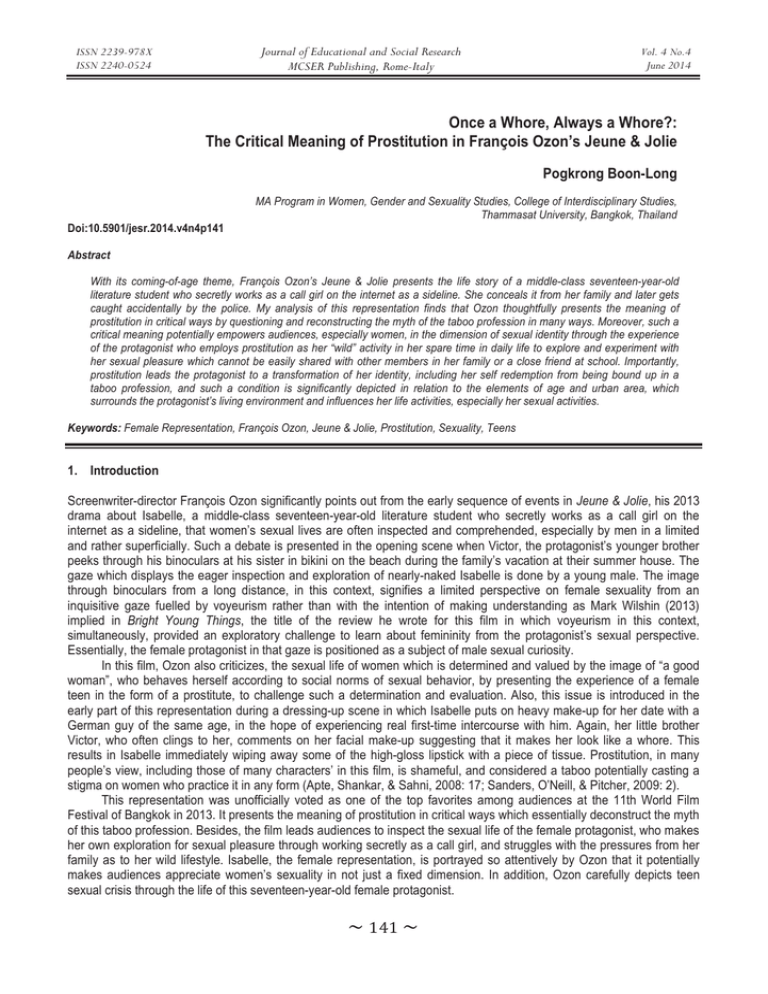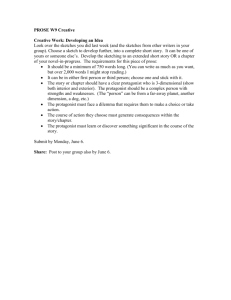
Journal of Educational and Social Research
MCSER Publishing, Rome-Italy
ISSN 2239-978X
ISSN 2240-0524
Vol. 4 No.4
June 2014
Once a Whore, Always a Whore?:
The Critical Meaning of Prostitution in François Ozon’s Jeune & Jolie
Pogkrong Boon-Long
MA Program in Women, Gender and Sexuality Studies, College of Interdisciplinary Studies,
Thammasat University, Bangkok, Thailand
Doi:10.5901/jesr.2014.v4n4p141
Abstract
With its coming-of-age theme, François Ozon’s Jeune & Jolie presents the life story of a middle-class seventeen-year-old
literature student who secretly works as a call girl on the internet as a sideline. She conceals it from her family and later gets
caught accidentally by the police. My analysis of this representation finds that Ozon thoughtfully presents the meaning of
prostitution in critical ways by questioning and reconstructing the myth of the taboo profession in many ways. Moreover, such a
critical meaning potentially empowers audiences, especially women, in the dimension of sexual identity through the experience
of the protagonist who employs prostitution as her “wild” activity in her spare time in daily life to explore and experiment with
her sexual pleasure which cannot be easily shared with other members in her family or a close friend at school. Importantly,
prostitution leads the protagonist to a transformation of her identity, including her self redemption from being bound up in a
taboo profession, and such a condition is significantly depicted in relation to the elements of age and urban area, which
surrounds the protagonist’s living environment and influences her life activities, especially her sexual activities.
Keywords: Female Representation, François Ozon, Jeune & Jolie, Prostitution, Sexuality, Teens
1. Introduction
Screenwriter-director François Ozon significantly points out from the early sequence of events in Jeune & Jolie, his 2013
drama about Isabelle, a middle-class seventeen-year-old literature student who secretly works as a call girl on the
internet as a sideline, that women’s sexual lives are often inspected and comprehended, especially by men in a limited
and rather superficially. Such a debate is presented in the opening scene when Victor, the protagonist’s younger brother
peeks through his binoculars at his sister in bikini on the beach during the family’s vacation at their summer house. The
gaze which displays the eager inspection and exploration of nearly-naked Isabelle is done by a young male. The image
through binoculars from a long distance, in this context, signifies a limited perspective on female sexuality from an
inquisitive gaze fuelled by voyeurism rather than with the intention of making understanding as Mark Wilshin (2013)
implied in Bright Young Things, the title of the review he wrote for this film in which voyeurism in this context,
simultaneously, provided an exploratory challenge to learn about femininity from the protagonist’s sexual perspective.
Essentially, the female protagonist in that gaze is positioned as a subject of male sexual curiosity.
In this film, Ozon also criticizes, the sexual life of women which is determined and valued by the image of “a good
woman”, who behaves herself according to social norms of sexual behavior, by presenting the experience of a female
teen in the form of a prostitute, to challenge such a determination and evaluation. Also, this issue is introduced in the
early part of this representation during a dressing-up scene in which Isabelle puts on heavy make-up for her date with a
German guy of the same age, in the hope of experiencing real first-time intercourse with him. Again, her little brother
Victor, who often clings to her, comments on her facial make-up suggesting that it makes her look like a whore. This
results in Isabelle immediately wiping away some of the high-gloss lipstick with a piece of tissue. Prostitution, in many
people’s view, including those of many characters’ in this film, is shameful, and considered a taboo potentially casting a
stigma on women who practice it in any form (Apte, Shankar, & Sahni, 2008: 17; Sanders, O’Neill, & Pitcher, 2009: 2).
This representation was unofficially voted as one of the top favorites among audiences at the 11th World Film
Festival of Bangkok in 2013. It presents the meaning of prostitution in critical ways which essentially deconstruct the myth
of this taboo profession. Besides, the film leads audiences to inspect the sexual life of the female protagonist, who makes
her own exploration for sexual pleasure through working secretly as a call girl, and struggles with the pressures from her
family as to her wild lifestyle. Isabelle, the female representation, is portrayed so attentively by Ozon that it potentially
makes audiences appreciate women’s sexuality in not just a fixed dimension. In addition, Ozon carefully depicts teen
sexual crisis through the life of this seventeen-year-old female protagonist.
̱ͳͶͳ̱
ISSN 2239-978X
ISSN 2240-0524
Journal of Educational and Social Research
MCSER Publishing, Rome-Italy
Vol. 4 No.4
June 2014
2. Jeune & Jolie and the French Classics with Prostitution Theme
Exploring some reviews of Jeune & Jolie over the internet, the author of this article found that some of them made
reference to a couple of famous French classics about prostitution: Jean Luc Godard’s Vivre Sa Vie: Film en Douze
Tableaux (1962) and Luis Buñuel’s Belle de Jour (1967). James Mottram (2013) praised Jeune & Jolie as “a modern-day
spin on the classic Bell de Jour,” with the protagonist undergoing a change from bored housewife to wild teenage
schoolgirl. These reviews have been taken as the primary literature for my study of Jeune & Jolie. As an outsider to
French culture, I consider that such a confined data source can create a limitation for me in making a reference to
contemporary French films with a prostitution theme in this study. Apart from these two French classics, another film with
a prostitution theme I can mention here is Call Girl (2012) which was shown in Bangkok in the context of films screened
for an international film festival. Call Girl, which depicts the true story of a young call girl, was on the program of Swedish
Film Festival held in April 2014, and Jeune & Jolie was screened at the World Film of Bangkok in November 2013.
With the theme of prostitution, Vivre Sa Vie leads audiences to explore the process by which a young and pretty
working-class woman becomes a prostitute. This issue is also one of the essential parts of Call Girl, a sensational drama
recounting how a fourteen-year-old girl with family problems is lured by an influential middle-aged bawd into call-girl
services for wealthy clients from political circles, and how such a business played a role in one of the big scandals in
Swedish political history during the 1970s. Belle de Jour portrays a beautiful housewife who explores sexuality for her
own pleasure by willingly engaging in what is reputed to be the world’s oldest profession (Flowers, 2011: ix, 27). The
female protagonist in Jeune & Jolie does likewise for similar reasons.
A clear difference in the character’s background on professing prostitution between the protagonist in Jeune &
Jolie and the other three is the decision making for leading their professions. Seventeen-year-old schoolgirl Isabelle,
prostitutes herself of her own accord at every step of way, finding inspiration from a television program, whereas the
character in Vivre Sa Vie is controlled by a young pimp who manages his business within a female trafficking network.
Call Girl’s fourteen-year-old protagonist is lured into the dark business as mentioned, and tends to live under torture with
the possibility of being blackmailed for the scandalous acts she has unwillingly engaged in. In Belle de Jour the woman is
introduced by chance, by a male acquaintance, to a group of courtesans in an apartment of a middle-aged madam who
she works afternoons for, similar to Isabelle’s after-class working hours. As for the plot, besides the issue of the
protagonist’s experimentation and exploration of sexuality focused on both Belle de Jour and Jeune & Jolie, an essential
issue that is clearly raised in the latter is the transformation of the protagonist’s identity, which manifests a teenage sexual
crisis on the part of the female characters.
Significantly, the life experience of Isabelle, the female protagonist, as a prostitute, paves the way for closer
inspection and exploration of the meaning of the term “prostitution” by questioning the myth of this taboo profession.
Ozon introduces such a critical issue by featuring Paris, presented in the form of elegant high-rise buildings and a modern
high-tech life style, as background to the film. In this study, I consider the film as a representation of Ozon’s own creative
process, which employs semiology inspired analysis to relate the issues of gender and sexuality.
3. The Critical Meaning of Prostitution in Jeune & Jolie
Isabelle, the young female protagonist in Jeune & Jolie, lives her life under pressure caused by her discontent with her
own sexual affairs, largely resulting from first-time intercourse with a German teenaged boy on vacation with family in
summer, and also partly result of the attitudes of her close-knit family and school friends over what appropriate sexual
conduct of a ‘good’ girl should be. Possessing an alternative secret life as a call girl who encounters various kinds of male
clients, Isabelle is able to explore and enjoy the sexual side of her life. By living a double life, the protagonist, as a
woman, creates her own opportunities to fulfill her sexual desires whilst living her life in the context of identity
transformation which enables her to earn life experiences as an individual and as a woman. With the contextualized life
experiences of the protagonist as a foundation, Ozon presents a critical meaning of prostitution, and deconstructs certain
perspectives on the myth of female sexuality and this still taboo profession.
In Jeune & Jolie, Ozon presents the critical meaning of prostitution in three major dimensions. In the first
dimension, prostitution is an activity through which women, as sex workers, can earn for themselves (Ahmed, 2014: 74;
Ditmore, 2011: 16; Murphy, 2010: 781). Isabelle sets her service rate for sex herself, and directly selects suitable clients
from the Internet and phone contacts. She chooses to provide sex services, as work in her spare time, weekdays after
school by dressing up as an office girl working in business circles. After learning the truth of Isabelle’s illicit activity from
the police, her mother confiscates a large part of Isabelle’s earnings from her sex work, which the young woman has
hidden in her closet, and decides herself to donate those earnings to a charity supporting the reintegration of prostitutes
̱ͳͶʹ̱
ISSN 2239-978X
ISSN 2240-0524
Journal of Educational and Social Research
MCSER Publishing, Rome-Italy
Vol. 4 No.4
June 2014
into society. That makes the protagonist who accidentally knows the truth about a secret affair between her mother and
Peter – a family close friend who is already married – feel very upset and angry at her mother. She wants to spend her
earnings on counselling with the psychiatrist her mother took her to see. Isabelle claims that those earnings come from
work she has performed all by herself, and the middle-aged male psychiatrist shows Isabelle his support on this issue by
joking too that he has a service rate. Naturally, prostitution in this context is not only an activity, but a profession which
requires physical energy and concentration (Dewey, 2011: 73-4). By strongly demonstrating her disapproval of
prostitution and interfereing by donating her daughter’s earnings to a charity which supports such an objectionable career
in her view, Isabelle’s mother has recklessly censured Isabelle’s way of life. Her decisions on things about the issue show
that she does not have a real understanding of Isabelle’s wishes and motivation for following this profession as her
sideline. Evidently, money is not the priority for Isabelle in her work. She implies this by setting her service fee for sex
such that it should reduce the addiction on encountering her clients, including numerous consequences which may arise
from her sex work.
Prostitution, in another dimension, provides a tempting opportunity for women to experiment at and explore their
sexuality. Isabelle’s confession to the policewoman reveals that she has found a chance to create great pleasure in her
life after encountering various kinds of male clients. When she was on her own either at school, or at home, she gets
aroused to work more with another clients. At the beginning of the film, when the protagonist has her first experience with
sexual intercourse on the beach under a broad night sky which should arouse her sexual desire to a high level, she
obviously feels unsatisfied with the experience, and with her partner. In later scenes which reveal Isabelle offering sexual
services, we can feel her unbridled pleasure in various sexual exploits including oral sex, sex from behind, sex while
standing in the center of spacious and expensive hotel room, and sitting on top of a client in the confines of a fancy car in
an underground parking lot, and especially the intoxicating pleasure she shares with Georges, her favorite elderly client
who she services many times and who dies in coitus with her sitting astride him in a luxurious hotel room. Causing
Georges’ death makes Isabelle feel dirty. Her guilt greatly diminishes her sex drive, and makes her consider quitting work
as a sex worker.
In the last dimension in this context, prostitution is a profession in which women can redeem themselves from
being trapped up. “A whore today, a whore forever” is the old saying delivered sarcastically to Isabelle by an aged client,
who pays her special rate because of his need for her express service, after finishing wild, hard and hot sex in his fancy
car in the underground parking lot. Hearing that expresson causes Isabelle to fix a stare still on the client as if she were
spellbound. It blatantly highlights the myth associated with this forbidden profession, casting a stigma on women that
correlates with promiscuity (Suchada, 2004: 207-8). Ozon carefully urges audiences to question this critical issue. At the
end of this representation, he deconstructs such a repressive perspective by allowing his female protagonist to redeem
herself from being trapped by the stigma of prostitution through a significant encounter with Alice, the aged wife of
deceased Georges, who conceals herself among Isabelle’s regular clients via her mobile phone.
To learn more about the last girl Georges enjoyed himself with before dying, Alice makes an appointment with
Isabelle at the same hotel. Upon meeting, Alice reveals her warm affection for Isabelle, and also recalls her past sexual
encounters. Alice met Georges at seventeen, the same age as Isabelle. The older woman had sexual fantasies at a
young age desiring to payment for lying with boys in the same way Isabelle had done, but she had now passed that age.
Alice brings Isabelle to the same room where Georges took his last breath with the young woman. She pays Isabelle’s
fee but does not expect sex, a gesture the protagonist at first misunderstands. Such a situation highlights one of
Isabelle’s practical skills as a professional sex worker ready to provide her service to anyone prepared to hire her without
knowing beforehand the clients’ genders. Alice simply asks Isabelle to lay down beside her on that unbridled deathbed.
Young Isabelle sincerely admits to the elderly widow that returning to this hotel room was vital for her. After a nap,
Isabelle later finds herself alone in bed. She sits up abruptly and, reviewing her brief encounter with the intimate stranger,
the young female protagonist’s face flashes cool pleasure, hinting at, the peace and calm state of her mind. Alice’s words
and manners encourage and value what Isabelle has been through with her sexual experiences. The sordidness Isabelle
felt caused by the guilt associated with Georges’ death in the throes of sex has been contained. The protagonist’s act of
sitting up abruptly on the bed mimics a sudden awakening from a dream. Significantly, in this context, Isabelle’s
experience of prostitution is like a dream in some period of her life, and she has now redeemed herself from being
trapped in this taboo profession by learning from her own life experience as it happens. Isabelle used to be a prostitute at
one stage of her life, and she might choose to re-engage at another time, like the time before when she started again
following a failed affair with Alex, her greenhorn classmate. Her decision to prostitute herself again at this time leads her
to meet mature and generous Alice for such a great redemption, which allows the young female protagonist and the
audience to realize that she is neither stigmatized nor trapped by the profession life-long as expressed in the saying
quoted by her wealthy aged client. Ozon brilliantly empowers the female protagonist and the audience with his clear
̱ͳͶ͵̱
ISSN 2239-978X
ISSN 2240-0524
Journal of Educational and Social Research
MCSER Publishing, Rome-Italy
Vol. 4 No.4
June 2014
signification of women’s life experiences through Alice, the aged character, who performs her essential mission by
deconstructing myth linked to this age-old profession.
By the meaning inherent in these stated dimensions, prostitution leads Isabelle to live her life with selfdetermination at an extreme level. The protagonist, as a young woman, secretly creates another desirable life of her own
to fulfill her sexual proclivities. Furthermore, the film shows that Isabelle is better at sexual activities in bed than some
male characters. In other words, the female protagonist plays the dominant role in bed as the one who can lead the male
characters to orgasm.
In addition, the urban area which surrounds the protagonist’s living environment and her teen age play important
roles on the protagonist’s exploration of her sexuality and the transformation of her identity. These two factors essentially
provide additional explanations in some certain ways to the meaning of prostitution in such critical dimensions as
discussed.
In this context, urban Paris where Isabelle lives and prostitutes herself anonymously over the internet, can be
considered the space in which the female protagonist leads her double life (Kingston & Sanders, 2010: 1-4). The
atmosphere of the city is created by way of the complexity with background surroundings such as the subway and
skyscrapers fused with an air of hi-tech communications. Such complexity provides a chance for the protagonist to live
her life in some degree of disguise, which directly relates to dressing up herself. At home and at school, Isabelle dresses
herself casually as a regular teen wearing no facial make-up or excessive hairdo. On performing her duty as a sex
provider in a luxurious hotel or a particular meeting place, the girl dresses as a businesswoman with enticing facial makeup. In this context, she employs her experience of living in an urban environment as a tactic for indulging in her own
everyday pleasures, including the experimentation and exploration of her sexuality. A magnificent shot in this film, which
highlights this issue, is the one that portrays a naked Isabelle enjoying intercourse from behind with a middle-aged client
while leaning against the glass partition of a room, viewed from outside. Above the glass partition through which the
couple’s naked bodies can be seen in suggestive detail, is the shadow of the city landscape composed of a group of
buildings.
As for the issue of age, Ozon raises a thoughtful discussion on a teen sexual crisis through the life experiences of
the protagonist and Claire, her close friend at school, who was unaware of Isabelle’s life on the wild side. The issue is
critically mentioned in the early part of this representation, especially in the sequence of Rimbaud’s poem recitation by
Isabelle and her literature classmates. The poem’s first and near-last lines are repeated in the sentence, “At seventeen,
you cannot be formal” which, in this context, suggests an opportunity for the chance for teenagers to experience and
experiment in life. Such a chance naturally relates to teenage crisis in many ways. The protagonist’s life experience
provides her with a lesson on this issue. The crisis for these female teens involves their first experience of sexual
intercourse. Both Isabelle and Claire are disappointed with their first making love-making because of their partners. The
German guy was so focused on his own orgasm that he left Isabelle feeling strange about him and the sex act of which,
in the early part of the film, she held expectations of fulfilled sexual desire. Her disappointment of this first experience
essentially leads her in a search for pleasure through prostitution and sex with male clients. Likewise, Claire does not
receive sufficient attention from her date after having sex. That makes Claire lose confidence, and arouses feelings of
loneliness and sadness so much so that she cries hard to Isabelle. The protagonist comforts her friend by recounting her
own sex experience. Isabelle lies to Claire that she is still a virgin, and promises to help resolve Claire’s sex problem.
Claire who does not know of Isabelle’s prostitution, feels relaxed and carries in the hope for true love and sexual
satisfaction.
From the issue mentioned above, Ozon also significantly judges that elders in Isabelle’s family, such as her
mother, have not tried to understand teenage desires and perspectives. Her mother considers Isabelle’s life experience
as a teen stereotypically. Besides, the protagonist’s mother herself behaves hypocritically by engaging in a secret affair
with a close friend of the family. That means she cheats on her spouse who is Isabelle’s stepfather. Unfortunately,
Isabelle’s mother does not recognize the taboo nature of her hidden relationship as perceived by people in society, and
thus fails to understand Isabelle’s taboo profession. Moreover, the protagonist’s mother clearly treats her in numerous
disdainful ways. When Isabelle implicitly reveals to her mother that she has known about her secret affair, her mother
avoids discussion on the issue and avoids it. Alternatively, from the situation in which Isabelle lies to Claire about her sex
life and virginity, the protagonist, as a teen behaves hypocritically to her close friend for the purpose of encouraging her
and relieving her of the enormous suffering caused by her sexuality. Another shameful hypocrisy Isabelle faces from an
elder during the early part of her profession to being as a sex worker happens when she is cheated on her fee for sex
services by a good-looking thirty-two-year-old man with a good career. This client, in fact, threatens to tell her family
about her sideline if she insists of charging him. Ozon suggests here that hypocrisy in the world of elders tends to lessen
the risk for teenagers in their experimentation and exploration of sex at a high level. Notably, what Isabelle does for Claire
̱ͳͶͶ̱
ISSN 2239-978X
ISSN 2240-0524
Journal of Educational and Social Research
MCSER Publishing, Rome-Italy
Vol. 4 No.4
June 2014
by making use of the hypocrisy of her sex life in enhancing Claire’s life situation, including offering encouragement to this
innocent friend of hers, can be considered an essential factor in making the protagonist beautiful as indicated in the title
of this representation.
Essentially, Ozon implies that the protagonist’s youth gives her a great chance to learn and gather experiences in
sex. This implication significantly relates to his storyline divided into several parts, which are determined by nature’s
seasons. In summer, the opening of the film, Isabelle engages in her first real intercourse. Thereafter, in autumn, she
makes her exploration into prostitution, and gains sexual pleasure with a variety of male clients. Then, Isabelle faces the
unexpected death of Georges, her most intimate client, in winter. In spring through the early part of the next summer, the
protagonist makes her own choice to lead her life out way from the myth of love by not maintaining her relationship with
her classmate Alex, who is unable to fulfill her sexual desires. To sarcastically present such an issue, Ozon foreshadows
their relationship by having Isabelle and Alex, after a night partying with their teen friends, take a romantic stroll together
to the city’s love lock bridge where the sweethearts come to declare their loves for each other. This film sequence leads
the audience, together with the two characters, to a view of the bridge’s railing from which hang a great number of various
kinds of locks symbolizing unbreakable love. However, this sequence in spring happens not long before their break-up
scene in the later sequence when the next summer begins. During that next summer, Isabelle encounters Alice who plays
an important part in her redemption from the shackles of prostitution. Explicitly that next summer, therefore, the
protagonist should get past the state in which she learns and earns from her experience into sexuality. Being a prostitute
for some certain period in a lifetime is merely something happening during a certain part of Isabelle’s life, and it may
simply pass like a dream, as revealed by her confession to the policewoman that “It was just an experience.” Such an
experience is an individual cause, and it is inappropriate to refer or compare it to any of the elder’s teenagehood. Ozon,
as well, highlights this issue sarcastically in the big quarrel scene between Isabelle and her mother, who tells her that
she, as once a teenager, understands well Isabelle’s life situation. The protagonist, who has no respect for her mother’s
hypocritical secret love affair, abruptly responds by asking her mother if she used to be a whore too. Isabelle’s mother
reacts to this with a slap to the young woman’s face.
The director also thoughtfully suggests that the female protagonist, in teenagehood, has a great potential to live
another life in accord with the transformation of her identity, from being an dividual who has some experience in sexuality,
to becoming the one who learns a good deal about it and uses it to fulfill her life. A couple of film sequences essentially
demonstrate this critical issue that Ozon presents. The first sequence is when Isabelle tries her first real intercourse with
her German date on the beach. Lying beneath her partner’s body, the protagonist feels none of the pleasure he feels.
Instead, she imagines herself standing not far away on the same beach staring back at her. When her lover reaches
orgasm, Isabelle’s other self disappears. This scene expressively reflects the protagonist’s alienation from her identity
prompted by sex, in a way that ADMIN LEAVE COMMENT (2013) analyses in her/his review of this film as “her
disappeared self.” The regard from Isabelle’s other self standing along the beach, back at Isabelle whose body is covered
by her lover as he seeks pleasure of it, crucially presents an image of a stare from the female character who is examining
a woman’s displeasure in the sex experience which needs an accurate understanding. At this point, Ozon carefully
advises the audience to avoid making stereotypical judgments on the sex experience of an individual, who, in this
context, is a female teenager searching for meaning in sexuality that conforms with her desire.
The other essential film sequence underlying Ozon’s issue related to the protagonist’s identity is presented near
the end of this representation when Isabelle spends time with Alice in the same hotel room in which the young woman
has witnessed Georges’ death before her very eyes. The shot which at first reveals Isabelle as a reflection in a broad
mirror, lying alone in bed, and then swiftly pans to capture her far real body, significantly conveys, in this context, the
integration of Isabelle’s self at present and her “disappeared self” as discussed. Such a transformation of the
protagonist’s identity is essentially created by encouragement and then redemption from guilt of sexual desire leading to
Georges’ death that Alice has provided, including, significantly, the fulfillment this female protagonist has earned from her
life of experimentation and exploration as a prostitute.
4. Conclusion
François Ozon’s Jeune & Jolie is a representation which raises the primary issues of women and sexuality with audience.
It presents a critical meaning of prostitution in three major dimensions: prostitution as an earning activity for women in
their free time; prostitution as a means by which women may explore and experiment with their sexuality; and prostitution
as a profession from which women can redeem themselves from being trapped. The urban setting which facilitates living
anonymously, and the cyber lifestyle can be considered as space for the female protagonist to lead her double life as a
young middle-class literature student on the one hand, and a sensual prosstitute on the other. In addition, Ozon
̱ͳͶͷ̱
ISSN 2239-978X
ISSN 2240-0524
Journal of Educational and Social Research
MCSER Publishing, Rome-Italy
Vol. 4 No.4
June 2014
emphasizes the teenage condition and sexual crisis in this film dealing with first intercourse experience for the
protagonist and her female classmate. He tacitly suggests that the protagonist’s youth offers her a great opportunity to
learn and gain the experience related to sexuality which ultimately leads to her transformation of identity. Significantly,
Ozon suggests that sexuality plays an important part in such a process.
5. Acknowledgments
The author of this article gratefully thanks Ajarn Krittaya Akanisdha and Asst. Prof. Chutima Pragatwuttisarn, Ph.D. for
their very kind help with English usage and vocabulary.
References
Admin Leave A Comment. 66th Cannes Film Festival review – Jeune et Jolie (2013). [Review of the film Jeune & Jolie, by François
Ozon]. Retrieved from http://www.flickeringmyth.com/2013/05/66th-cannes-film-festival-review-jeune.html
Ahmed, A. (2014). Think again: prostitution. Foreign Policy, Jan-Feb(204), 74-8. Retrieved from http://content.ebscohost.com
/pdf29_30/pdf/2014/FPO/01Jan14/93911129.pdf?T=P&P=AN&K=93911129&S=R&D=bth&EbscoContent=dGJyMMvl7ESeqa44y
OvsOLCmr0yeprRSs624SrWWxWXS&ContentCustomer=dGJyMPGqtU%2
Apte, H., Shankar, V. K., & Sahni, R. (2008). Introduction. In Apte, H., Shankar, V. K., and Sahni, R. (Ed.), Prostitution and beyond : An
analysis of sex workers in India, (pp. 13-8). Los Angeles, CA : SAGE.
Altmayer, E., and Altmayer N. (Producers), & Ozon, F. (Director). (2013). Jeune & jolie [Motion picture]. France: Mandarin Films.
Braunberger, P. (Producer), & Godard, J. (Director). (1962). Vivre sa vie: Film en douze tableaux [Motion picture]. France: Les Films de
la Pléiade, Pathé Consortium Cinéma.
Dewey, S. (2011). On the boundaries of the global margins: Violence, labor, and surveillance in a rust belt topless bar. In Dewey, S., and
Kelly, P. (Ed.), Policing pleasure : Sex work, policy, and the state in global perspective, (pp. 73-85). New York : New York
University Press.
Ditmore, M. H. (2011). Prostitution and sex work. Santa Barbara, California : Greenwood.
Flowers, R. B. (2011). Prostitution in the digital age : Selling sex from the suite to the street. Santa Barbara, California: Praeger.
Hakim, Raymond, and Hakim, Robert. (Producers), & Buñuel, L. (Director). (1967). Belle de Jour [Motion picture]. France: Paris Films
Production.
Kingston, S., & Sanders, T. (2010). Introduction new sociologies of sex work in perspective. In Sanders, T., Kingston, S., & Hardy, K.
(Ed.), New sociologies of sex work, (pp. 1-8). Farnham, Surrey, England : Ashgate Pub.
Mottram, J. (2013). The secret diary of a call girl. [Review of the film Jeune & Jolie, by François Ozon]. Retrieved from
http://www.totalfilm.com/reviews/cinema/jeune-et-jolie
Murphy, L. S. (2010). Understanding the social and economic contexts surrounding women engaged in street-level prostitution. Issues in
Mental Health Nursing, 2010 Dec; 31 (12): 775-84. Retrieved from http://eds.a.ebscohost.com/eds/pdfviewer/pdfviewer?
vid=2&sid=1f26b936-c410-40e2-a4c2-146d3ea35cb0%40sessionmgr4002&hid=4202
Sanders, T., O'Neill, M., & Pitcher, J. (2009). Prostitution : Sex work, policy and politics. London : SAGE.
Spång, M. (Producer), & Marcimain, M. (Director). (2012). Call girl [Motion picture]. Sweden: Garagefilm International.
Suchada T. (2004). The fluidity of Thai women's gendered and sexual subjectivities. Culture, Health & Sexuality, 6(3), 205-19. Retrieved
from http://www.jstor.org/stable/4005368
Wilshin, M. (2013). Bright young things. [Review of the film Jeune & Jolie, by François Ozon]. Retrieved from http://www.dogandwolf.com
/2013/11/film-review-young-and-beautiful-jeune-et-jolie-2013/
̱ͳͶ̱








